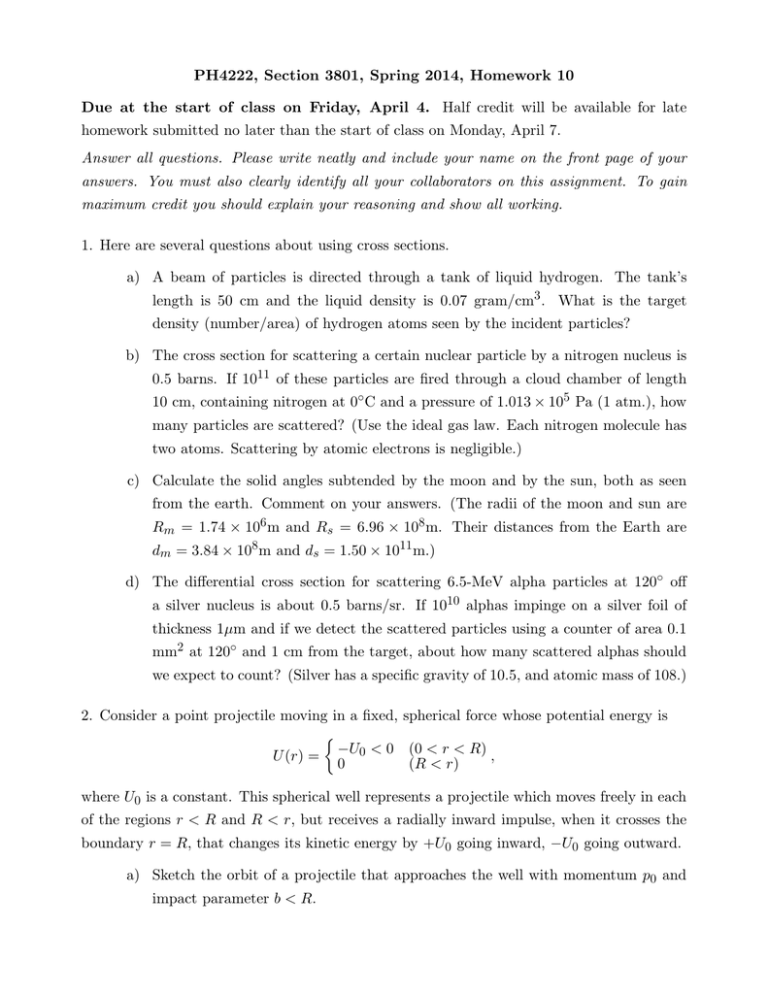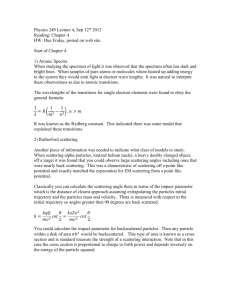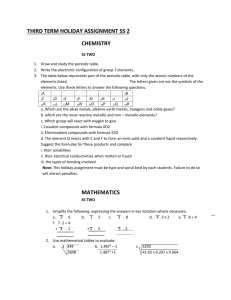PH4222, Section 3801, Spring 2014, Homework 10
advertisement

PH4222, Section 3801, Spring 2014, Homework 10 Due at the start of class on Friday, April 4. Half credit will be available for late homework submitted no later than the start of class on Monday, April 7. Answer all questions. Please write neatly and include your name on the front page of your answers. You must also clearly identify all your collaborators on this assignment. To gain maximum credit you should explain your reasoning and show all working. 1. Here are several questions about using cross sections. a) A beam of particles is directed through a tank of liquid hydrogen. The tank’s length is 50 cm and the liquid density is 0.07 gram/cm3 . What is the target density (number/area) of hydrogen atoms seen by the incident particles? b) The cross section for scattering a certain nuclear particle by a nitrogen nucleus is 0.5 barns. If 1011 of these particles are fired through a cloud chamber of length 10 cm, containing nitrogen at 0◦ C and a pressure of 1.013 × 105 Pa (1 atm.), how many particles are scattered? (Use the ideal gas law. Each nitrogen molecule has two atoms. Scattering by atomic electrons is negligible.) c) Calculate the solid angles subtended by the moon and by the sun, both as seen from the earth. Comment on your answers. (The radii of the moon and sun are Rm = 1.74 × 106 m and Rs = 6.96 × 108 m. Their distances from the Earth are dm = 3.84 × 108 m and ds = 1.50 × 1011 m.) d) The differential cross section for scattering 6.5-MeV alpha particles at 120◦ off a silver nucleus is about 0.5 barns/sr. If 1010 alphas impinge on a silver foil of thickness 1µm and if we detect the scattered particles using a counter of area 0.1 mm2 at 120◦ and 1 cm from the target, about how many scattered alphas should we expect to count? (Silver has a specific gravity of 10.5, and atomic mass of 108.) 2. Consider a point projectile moving in a fixed, spherical force whose potential energy is −U0 < 0 (0 < r < R) U (r) = , 0 (R < r) where U0 is a constant. This spherical well represents a projectile which moves freely in each of the regions r < R and R < r, but receives a radially inward impulse, when it crosses the boundary r = R, that changes its kinetic energy by +U0 going inward, −U0 going outward. a) Sketch the orbit of a projectile that approaches the well with momentum p0 and impact parameter b < R. b) From energy conservation, find the particle’s momentum p inside the well (r < R). c) Let ζ denote the momentum ratio p0 /p, and d the projectile’s distance of closest approach to the origin. From angular momentum conservation, show that d = ζb. d) It can be shown that the scattering angle θ is given as a function of b by: ζb b . θ = 2 arcsin − arcsin R R By differentiating θ with respect to b, find an expression for the differential cross section as a function of b. What is the maximum angle of scattering? e) By integrating dσ/dΩ over all directions, find the total cross section. 3. The general appearance of the scattering orbit in a spherically symmetric potential U (r) is shown in the figure. It is symmetric about the direction u of closest approach. If ψ is the projectile’s polar angle, measured from the direction u, then ψ ⇒ ±ψ0 as t ⇒ ±∞ and the scattering angle is θ = π − 2ψ0 , where ψ0 is equal R to ψ̇ dt taken from the time of closest approach to ∞. Using the now-familiar trick, one can rewrite this integral as R (ψ̇/ṙ)dr. Next ψ̇ can be rewritten in terms of the angular momentum l and r, and ṙ can be rewrite in terms of the energy E and the effective potential Ueff . Hence, it can be proved that: Z ∞ (b/r 2 )dr p . θ =π−2 1 − (b/r)2 − U (r)/E rmin Provided this integral can be evaluated, it gives θ in terms of b, and thus allows the differential cross section dσ/dΩ to be evaluated. a) A particle with energy E is scattered by a fixed, repulsive 1/r 3 force field, with potential energy U = γ/r 2. Use the relation above to find θ in terms of b. [Hint: You will need to find rmin for the case E > 0 in order to evaluate the integral.] b) Solve your equation for θ in terms of b to get b in terms of θ. c) Hence show that the differential cross section is: γ π 2 (π − θ) dσ = . dΩ E θ 2 (2π − θ)2 sin θ d) Compare the singularity of this as θ ⇒ 0 with the corresponding singularity in the Coulomb case (i.e., for Rutherford scattering). e) Compare the dependence on E with that in the Coulomb case. 2











